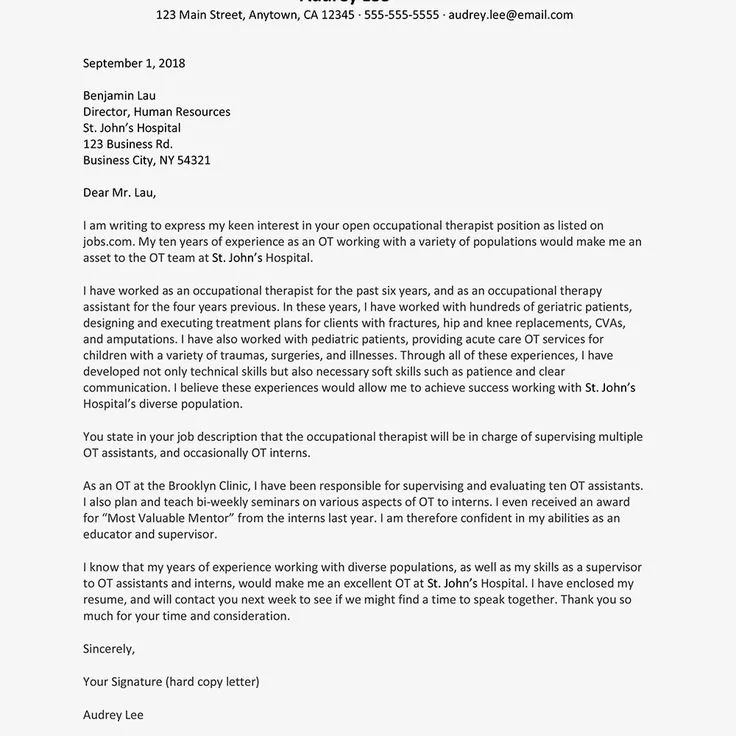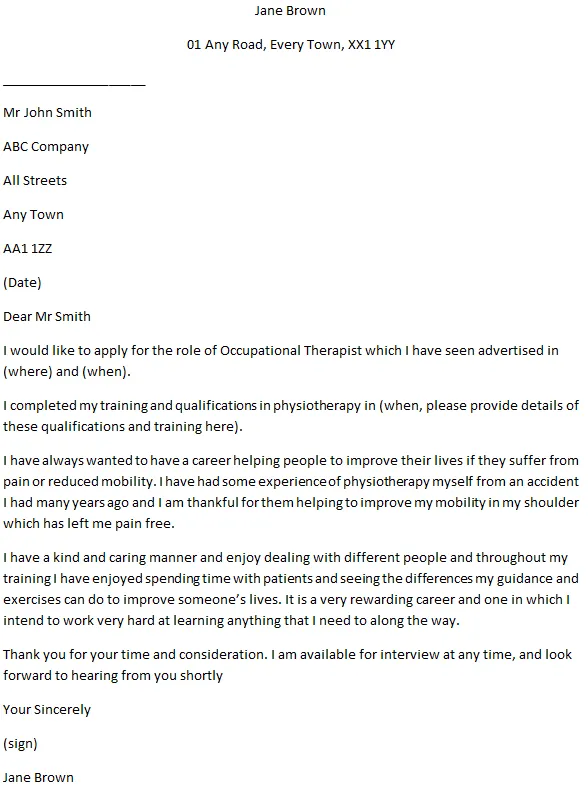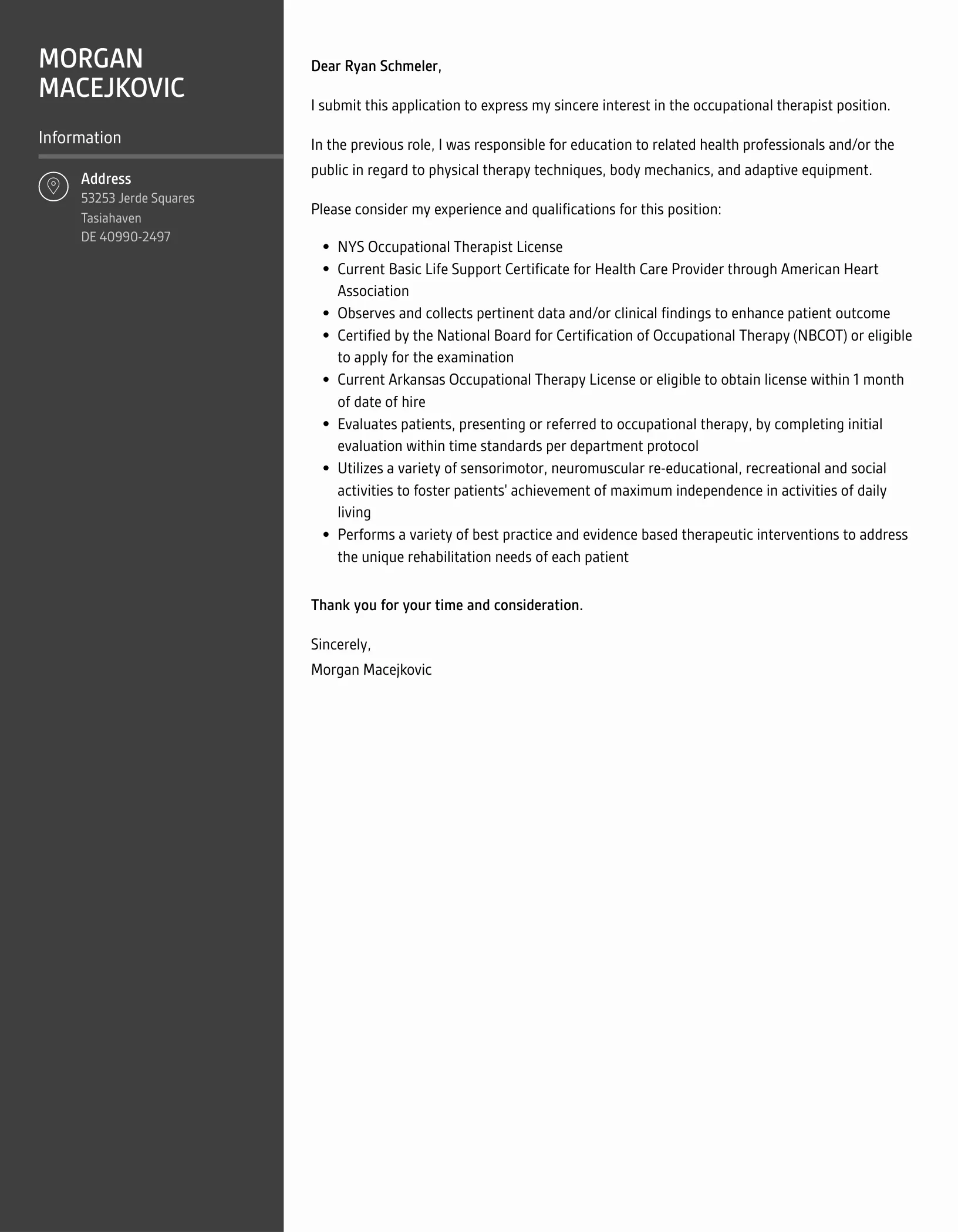Understanding the Importance of an Occupational Therapist Cover Letter
An occupational therapist cover letter is more than just a formality; it’s your initial opportunity to make a strong impression on potential employers. In a competitive job market, a well-crafted cover letter can significantly increase your chances of securing an interview. It serves as your personalized introduction, allowing you to showcase your unique skills, experience, and passion for occupational therapy. This guide will walk you through creating a compelling cover letter that highlights your qualifications and sets you apart from other applicants. A well-written cover letter is a critical tool for any occupational therapist looking to advance their career.
Why a Cover Letter Matters
A cover letter provides context to your resume. It allows you to elaborate on your experiences, explain career transitions, and demonstrate how your skills align with the specific requirements of the job. It’s where you can weave a narrative about your career journey and personal motivations. Furthermore, a cover letter gives you the chance to express your enthusiasm for the role and the organization, showing that you’ve done your research and are genuinely interested in the opportunity. This level of personalization is something a resume alone cannot achieve. In the world of occupational therapy, a strong cover letter demonstrates communication and empathy skills, which are vital for patient care.
Highlighting Your Skills and Experience

Your cover letter should be a showcase of your abilities and accomplishments. Focus on highlighting the skills that are most relevant to the job you’re applying for. This includes clinical skills, such as patient assessment, treatment planning, and intervention techniques, as well as soft skills like communication, teamwork, and problem-solving. Use specific examples to illustrate how you have successfully utilized these skills in previous roles. Consider your experience with various patient populations, such as pediatrics, geriatrics, or mental health, depending on the job’s focus. The more detailed and specific you are, the more compelling your letter will be. Emphasize how your expertise aligns with the needs of the specific position.
Key Elements of an Effective Occupational Therapist Cover Letter
A well-structured cover letter is essential for conveying your qualifications clearly and effectively. It needs to include the essential elements of a professional document, such as contact information, a salutation, a body that highlights your skills, and a professional closing. Paying close attention to these key components will ensure your cover letter makes a positive impact.
Contact Information and Date
Begin your cover letter with your contact information: your full name, phone number, email address, and possibly your LinkedIn profile URL. Ensure this information is accurate and up-to-date. Following your contact information, include the date. This simple yet crucial detail is essential for any formal correspondence and sets the foundation for a professional presentation. Keep your address optional unless specifically requested. This ensures the employer has all necessary means to contact you promptly.
The Hiring Manager’s Name and Title

Address your cover letter to the hiring manager by name whenever possible. This shows that you’ve taken the time to research the organization and are personally invested in the position. If you can’t find the hiring manager’s name, use a professional salutation such as “Dear Hiring Manager” or “Dear [Department Name] Hiring Team.” This personalization significantly increases your chances of making a favorable impression. It shows attention to detail and a commitment to your application. If you are applying for a specific role, make sure you find the direct hiring manager.
A Compelling Opening Paragraph
The opening paragraph is your opportunity to grab the reader’s attention. State the position you’re applying for and briefly mention where you saw the job posting. Then, immediately express your enthusiasm for the role and the organization. In a few sentences, summarize your most relevant qualifications and experience, highlighting what makes you an ideal candidate. This should be an attention-grabbing statement that immediately sets a positive tone. Make the recruiter eager to read the rest of your letter. This initial impression can determine whether the hiring manager continues reading.
Showcasing Your Relevant Skills and Experience
The body of your cover letter should be where you delve deeper into your skills and experiences. This section is where you will elaborate on your most relevant qualifications, aligning them directly with the job description’s requirements. Back up your claims with concrete examples that illustrate your achievements and the positive impact you have made in previous roles. Focus on the skills and experiences that directly relate to the position you are applying for. Make sure you show how you have demonstrated those skills.
Quantifying Your Accomplishments

Use numbers and data to quantify your accomplishments whenever possible. Instead of saying, “Improved patient outcomes,” say, “Improved patient outcomes by 15% through the implementation of a new therapy protocol.” Providing specific, measurable results demonstrates your impact and credibility. Include metrics such as the number of patients you have treated, the success rate of your interventions, or any cost savings you achieved. Quantifiable achievements make your cover letter more compelling and help the hiring manager easily understand the value you bring to the table. Numerical data is a key element in showcasing the effectiveness of your skills.
Tailoring Your Letter to the Job Description
Customize your cover letter for each job you apply for. Carefully review the job description and identify the key requirements and desired skills. Then, use your cover letter to demonstrate how your qualifications align with these specific needs. Use the same keywords and phrases from the job description in your cover letter. This shows that you have a clear understanding of the role and are a good fit for the position. Generic cover letters are easily spotted and often discarded. Tailoring your letter shows you’ve invested time and effort in the application process.
Demonstrating Passion and Enthusiasm
Show your enthusiasm for the role and the organization. Highlight what specifically interests you about the position and why you are excited about the opportunity. Share what you know about the company’s mission, values, and recent achievements. You can also mention any professional goals you have. This genuine interest helps you stand out from other candidates and portrays you as someone who is truly dedicated to the field. Injecting your personality and passion into your cover letter is a great way to show your interest.
The Closing Paragraph: Call to Action

In your closing paragraph, reiterate your interest in the position and express your availability for an interview. Thank the hiring manager for their time and consideration. Include a polite but firm call to action, such as “I am eager to discuss how my skills and experience can benefit your team” or “I look forward to hearing from you soon.” End with a professional closing, such as “Sincerely” or “Best regards,” followed by your typed name. A strong call to action shows your commitment and eagerness.
Formatting and Proofreading Your Cover Letter
The presentation of your cover letter can be just as important as its content. Ensure your letter is easy to read and free of errors. Pay attention to formatting, font choices, and proper grammar. This will demonstrate your professionalism and attention to detail, which are essential qualities for an occupational therapist.
Font and Formatting Guidelines
Choose a professional and easy-to-read font, such as Times New Roman, Arial, or Calibri, with a font size between 10 and 12 points. Use single-spaced lines within paragraphs and double-spaced lines between paragraphs. Align your text to the left and avoid using full justification. Ensure that your margins are set to one inch on all sides. Use clear headings and subheadings to organize the information and improve readability. Good formatting significantly enhances the overall appearance of your cover letter, making it more appealing to the reader.
Proofreading for Errors

Carefully proofread your cover letter for any grammatical errors, spelling mistakes, or typos. Errors can undermine your credibility and give the impression of carelessness. Read your letter aloud to catch any awkward phrasing or inconsistencies. Use a grammar checker and spell-checker, but don’t rely on them entirely; they can sometimes miss errors. Have someone else review your cover letter. A fresh pair of eyes can often spot mistakes that you might have overlooked. Proofreading ensures your letter is polished and professional. A clean and error-free cover letter makes a positive impression.
Seeking Feedback
Ask trusted colleagues, mentors, or career counselors to review your cover letter. They can provide valuable feedback on the content, clarity, and overall effectiveness of your letter. Ask them to assess whether your letter effectively communicates your skills and experience and whether it aligns with the job description. Ask them to check for grammatical errors and formatting issues. Incorporate their suggestions to improve your cover letter before submitting your application. Feedback improves your cover letter, leading to more interviews.
Common Mistakes to Avoid in Your Cover Letter
Avoiding common pitfalls can significantly improve the effectiveness of your cover letter. Recognize what to avoid will ensure your application stands out. It shows your commitment to professionalism and attention to detail.
Generic Cover Letters
Avoid using a generic, one-size-fits-all cover letter. Such letters do not demonstrate that you have taken the time to understand the specific needs of the role or the organization. Customizing your cover letter for each job application is crucial. Address the specific requirements of the job description and tailor your content to highlight the skills and experiences that are most relevant to the position. A personalized cover letter shows the hiring manager that you are genuinely interested and invested in the opportunity.
Focusing Solely on Duties
Focusing solely on your past duties and responsibilities is a common mistake. Instead of simply listing your tasks, focus on your achievements and results. Use the cover letter to showcase how you have made a positive impact in your previous roles. Quantify your accomplishments with specific metrics and provide examples of how you have used your skills to improve patient outcomes, streamline processes, or contribute to team success. Focus on what you have achieved, not just what you have done.
Ignoring the Job Description
Failing to address the requirements listed in the job description is a major mistake. Read the job description carefully and identify the key skills, qualifications, and experiences the employer is seeking. Then, tailor your cover letter to demonstrate how your skills and experiences align with these requirements. Use the same keywords and phrases from the job description to show you understand the role and are a good fit. Ignoring the job description will make your application seem irrelevant and less likely to be considered.
Using Clichés and Jargon
Avoid using clichés, generic phrases, and industry jargon that can make your cover letter sound unoriginal and insincere. Instead of using overused phrases like “hardworking team player” or “results-oriented professional,” use specific examples and quantifiable results to showcase your skills and achievements. Write in a clear, concise, and engaging style. Using jargon can confuse the reader. Your aim is to present yourself in a unique and authentic way.
In conclusion, creating a compelling occupational therapist cover letter requires a strategic approach. Focus on highlighting your skills, tailoring your letter to the job description, and demonstrating your passion for the field. By following these guidelines and avoiding common mistakes, you will significantly improve your chances of securing an interview and landing your dream OT job. Good luck with your job search!
